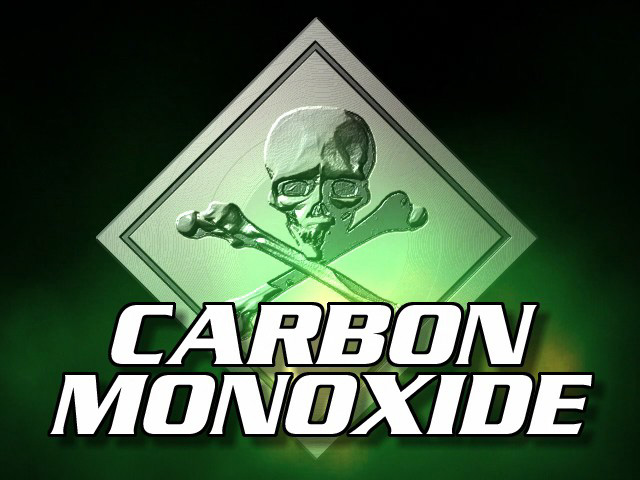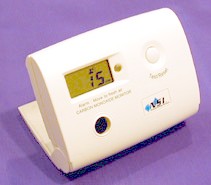
The Facts on Carbon Monoxide Poisoning
by Aarthi Iyer, MPH, Education Coordinator,
Regional Center for Poison Control and PreventionWhen parents tuck their children into bed at night, they usually feel assured that they're as safe as can be. But a "silent killer" could be on the loose in some homes, putting the whole family at risk of illness or even death.
What is carbon monoxide?
Carbon monoxide (CO) is a gas that is produced when fuel—gasoline, propane, natural gas, oil, wood, or coal—is burned. CO is extremely dangerous to people when emitted in an enclosed, unventilated area, such as a house, garage or car.
or for more information,
call your local poison center:
1-800-222-1222.Why is it harmful?
When CO is breathed, it is absorbed into the bloodstream and displaces oxygen necessary to vital organs. It can eventually cause permanent brain damage and death.CO is especially dangerous because it cannot be seen or smelled. People may feel ill or become unconscious without realizing they are being poisoned and need to get to fresh air immediately.
How would someone be exposed to CO?
Winter is when most CO poisoning incidents happen, because people use heaters, leave cars idling to warm up, and because snow drifts can block vents and tailpipes. Poisoning can happen when:
- A furnace, gas stove or water heater is faulty or installed improperly.
- The outside vent to a fuel-burning appliance becomes covered with snow.
- A fireplace chimney or stove pipe becomes clogged or blocked.
- A charcoal grill is used indoors.
- A car or gas-powered snow- or leaf-blower is left running in a closed garage.
- A car is running while parked with snow blocking the tailpipe.
With electric heaters and appliances, you do not need to worry about CO.
Detecting CO
- Install CO detectors in a central area on every floor and near sleeping areas.
- Detectors should be placed at least five feet above the ground, as CO rises.
- Hard-wired and plug-in models won't work during a power outage.
- Like smoke detectors, batteries need to be replaced each year.
What happens during poisoning?
Both children and adults can become very ill and even die within minutes or hours of exposure, depending on the level. Pregnant women, their unborn children, babies, heavy smokers, and people with anemia, heart or lung disease may be affected more quickly or seriously. Symptoms and effects vary between individuals, even at the same level of CO exposure, but people typically experience flu-like symptoms, including: dizziness, fatigue, weakness, headache or vomiting, trouble breathing, confusion, ringing in the ears, heart fluttering, gastrointestinal complaints, increased blood pressure, or bright red or pink skin, mucous membranes or nails.However, death from CO poisoning can result even if none of these symptoms occur first. In some cases, people fall unconscious before ever feeling ill.
Some CO poisoning survivors have described drifting in and out of consciousness, but being completely immobilized and unable to get themselves out of the area.
How many people die from CO exposure?
According to the Journal of the American Medical Association, 1,500 Americans die each year from accidental exposure to CO, and there are more than 10,000 injuries each year. Although most CO poisoning happens during a one-time sudden incidence, it is possible to suffer from chronic CO poisoning. This is when someone is exposed to low levels over weeks or months (for instance, due to a faulty oil-burning furnace), and experiences symptoms over that time.
How can you prevent exposure?
It's important to have your fuel-burning appliances inspected by a qualified professional at least once each year. But the most important thing you can do is to have a CO detector in your home. When a sleeping 10-year-old girl died in her home last year because a snow drift blocked an outside vent, the state of Massachusetts passed "Nicole's Law," requiring all residential buildings to be equipped with CO detectors. Other states have passed similar laws.Most CO detectors sound an alarm when levels have been at 70 ppm for an hour, or sooner if levels are higher. Although symptoms usually go unnoticed at that level, it can still be very dangerous. You should still have a monitor that can detect much lower levels. See the NSI 3000 Low level Monitor Page for information on one of the best monitors on the market.
For more information on Carbon Monoxide please e-mail negveskyenterprises@verizon.net or call 570-280-9814.
Links:
- http://www.epa.gov/iaq/co.html
- http://www.cpsc.gov/cpscpub/pubs/466.html
- http://en.wikipedia.org/wiki/Carbon_monoxide
